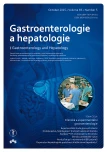Home parenteral nutrition – its importance and use in clinical practice
Authors:
A. Fojtová; B. Norek; T. Zamborský; M. Bátovský
Authors‘ workplace:
Gastroenterologická klinika SZU a UN Bratislava, Slovenská republika
Published in:
Gastroent Hepatol 2015; 69(5): 449-452
Category:
Chapters from internal medicine: Review Article
doi:
https://doi.org/10.14735/amgh2015449
Overview
Home parenteral nutrition is an alternative pathway in patients with irreversible failure of intestinal functions, in whom enteral nutrition is either not possible or is insufficient in the long term, with growing energetic deficiency. The initiation of home parenteral nutrition improves patients’ quality of life and also the course of the disease, leading to an optimisation of clinical symptoms of malnutrition. The most common indications for the initiation of home parenteral nutrition include an extensive reduction of the absorption area after intestinal resection (in patients with surgical complications of Crohn’s disease, ischemic necrosis of the small intestine due to VMS thrombosis, embolism or closure of the AMS), functional failure of the gut from various causes and cases of cancer with sufficient utilisation of essential nutrients.
Key words:
home parenteral nutrition – malnutrition – intestinal failure – short bowel syndrome
The authors declare they have no potential conflicts of interest concerning drugs, products, or services used in the study.
The Editorial Board declares that the manuscript met the ICMJE „uniform requirements“ for biomedical papers.
Submitted:
2. 10. 2015
Accepted:
8. 10. 2015
Sources
1. Fleming CR, Remington M. Intestinal failure. In: Hill GL (ed.). Nutrition and the surgical patient. Edinburgh: Churchill Livingstone 1981: 219–235.
2. O’Keefe SJ, Buchman AL, Fishbein TM et al. Short bowel syndrome and intestinal failure: consensus definitions and overview. Clin Gastroenterol Hepatol 2006; 4(1): 6–10.
3. D’Antiga L, Goulet O. Intestinal failure in children: the European view. J Pediatr Gastroenterol Nutr 2013; 56(2): 118–126. doi: 10.1097/MPG.0b013e318268a9e3.
4. Pironi L, Goulet O, Buchman A et al. Outcome on home parenteral nutrition for benign intestinal failure: a review of the literature and benchmarking with the European prospective survey of ESPEN. Clin Nutr 2012; 31(6): 831–845. doi: 10.1016/j.clnu.2012.05.004.
5. NHS National Commissioning Group for highly specialised services. Strategic framework for intestinal failure and home parenteral nutrition services for adults in England [online]. Available from: www.specialisedservices.nhs.uk/library/28/Strategic_Framework_for_Intestinal_Failure_and_Home_Parenteral_Nutrition_Services_for_Adults_in_England_1.pdf.
6. Dreesen M, Foulon V, Hiele M et al. Quality of care for cancer patients on home parenteral nutrition: development of key interventions and outcome indicators using a two-round Delphi approach. Support Care Cancer 2013; 21(5): 1373–1381. doi: 10.1007/s00520-012-1679-1.
7. Bozzetti F, Santarpia L, Pironi L et al. The prognosis of incurable cachectic cancer patients on home parenteral nutrition: a multicentre observational study with prospective follow-up of 414 patients. Ann Oncol 2014; 25(2): 487–493. doi: 10.1093/annonc/mdt549.
8. Dreesen M, Foulon V, Vanhaecht K et al. Guidelines recommendations on care of adult patients receiving home parenteral nutrition: a systematic review of global practices. Clin Nutr 2012; 31(5): 602–608. doi: 10.1016/j.clnu.2012.02.013.
9. Pironi L, Hébuterne X, Van Gossum A et al. Candidates for intestinal transplantation: a multicenter survey in Europe. Am J Gastroenterol 2006; 101(7): 1633–1643.
10. Pironi L, Joly F, Forbes A et al. Home Artificial Nutrition & Chronic Intestinal Failure Working Group of the European Society for Clinical Nutrition and Metabolism (ESPEN). Long-term follow-up of patients on home parenteral nutrition in Europe: implications for intestinal transplantation. Gut 2011; 60(1): 17–25. doi: 10.1136/gut.2010.223255.
11. Amiot A, Joly F, Alves A et al. Long-term outcome of chronic intestinal pseudo-obstruction adult patients requiring home parenteral nutrition. Am J Gastroenterol 2009; 104(5): 1262–1270. doi: 10.1038/ajg.2009.58.
12. Dibb M, Carlson G, Abraham A et al. OC-034 Salvage of central venous catheters in HPN catheter-related blood stream infections is safe and effective: 18 years experience from a national centre. Gut 2012; 61 (Suppl 2): A14–A15. doi:10.1136/gutjnl-2012-302514a.34.
13. Gabe SM, Culkin A. Abnormal liver function tests in the parenteral nutrition fed patient. Frontline Gastroenterol 2010; 1: 98–104. doi:10.1136/fg.2009.000521.
14. National Institute of Clinical Excellence. Nutrition support in adults: oral nutrition support, enteral tube feeding and parenteral nutrition [online]. Available from: nice.org.uk/CG32/Guidance/pdf/ English.
15. Fitzgerald KA, MacKay MW. Calcium and phosphate solubility in neonatal parenteral nutrient solutions containing TrophAmine. Am J Hosp Pharm 1986; 43(1): 88–93.
Labels
Paediatric gastroenterology Gastroenterology and hepatology SurgeryArticle was published in
Gastroenterology and Hepatology

2015 Issue 5
Most read in this issue
- Endoscopic histologisation of diminutive colorectal polyps. Are we ready for a change?
- Screening colonoscopy among elderly patients over 70 years
- Home parenteral nutrition – its importance and use in clinical practice
- First experience with digital Spyglass™ DS in Slovakia from the gastroenterology department of the Trnava University Hospital
